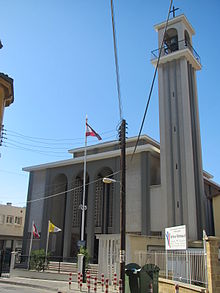Archeparchy of Cyprus Archeparchy Cyprensis Maronitarum | |
|---|---|
 | |
| Location | |
| Country | Cyprus |
| Statistics | |
| Population - Catholics | (as of 2013) 10,400 |
| Parishes | 12 |
| Information | |
| Denomination | Catholic Church |
| Sui iuris church | Maronite Church |
| Rite | West Syro-Antiochene Rite |
| Established | 1357 |
| Cathedral | Our Lady of Grace Cathedral (Nicosia) |
| Patron saint | Our Lady of Grace |
| Current leadership | |
| Pope | Francis |
| Patriarch | Bechara Boutros al-Rahi |
| Archeparch | Selim Jean Sfeir |
The Archeparchy of Cyprus[1][2] (Latin: Archeparchy Cyprensis Maronitarum) is a seat of the Maronite Church immediately subject to the Holy See. It is currently ruled by Archeparch Selim Jean Sfeir.
The archeparchy extends its jurisdiction over all the faithful Maronites of the island of Cyprus. Its arcieparchial seat is the city of Nicosia, where is located the Our Lady of Grace Cathedral (Nicosia).
The archeparchy at the end of 2013 out of a population of 838,897 people had 10,400 baptized, corresponding to 1.2% of the total. Its territory is divided into 12 parishes.
The Maronite community of Lebanon arrived and settled in the northern part of Cyprus during the period between the 9th and 12th centuries, and went through all the vicissitudes of the Christian community of the island: the 1191–1473 French occupation under the House of Lusignan, rule under the Venetians from 1473 to 1571, and Ottoman feudalism from 1571 to 1878. The largest Maronite migrations were in the years 1224, 1570, 1596, 1776 and 1878.[citation needed]
A Cypriot Maronite community in communion with Rome is reported since 1316 when a Maronite bishop, Hananya, who during the reign of the Lusignan took office in Cyprus.[3] The Catholic Bishops' series begins in 1357, when in the hands of the Latin bishop of Nicosia the Maronite community with his bishop emit a profession of the Catholic faith. This union is confirmed and reinforced by the Papal bull Benedictus sit Deus promulgated by Pope Eugene IV at the Council of Florence on August 7, 1455.
The Maronite community of Cyprus was the second largest community of Eastern Christians, after the Greeks. During the occupation of the island by officially Latin states, with the first Lusignan and then by the Venetians, the Maronites increased in number, thanks to the many properties and privileges granted to them by the new rulers of the island; they were present in sixty villages and, as estimated by Hackett,[4] the number of faithful rose to around 180,000. In 1514, the Maronite Patriarch informed Pope Leo X about the machinations of and the seizure of Maronite churches by the Latin bishop of Nicosia.[citation needed]
The Ottoman occupation of Cyprus from 1571 to 1878 saw a continued decline of the Maronite community, with drastically fewer faithful and of communities, as Maronites were driven out of their villages, the churches were destroyed, and the bishop was forced from his episcopal see.[citation needed]
With the death of Bishop Luc, a Cypriot, in 1673 there were not Maronite bishop of Cyprus till 1878. The bishops of Cyprus visited only sporadically the island, and the remaining Maronite faithful were cared by Franciscans (OFM). In 1735 were sent by the Superior general of the OML two monks to Cyprus, and they build a school for the Maronite community, which was inaugurated in 1763 by the synod of Maronite bishops, because the seat of the Bishop of Cyprus should initially remain in Lebanon.[citation needed]
The archeparchy was canonically erected in the Maronite Synod of Mount Lebanon in 1736. Since the end of the 16th century, the Maronite bishops, who until then had always resided in Nicosia, began to put their home on the mainland and returned only on the island starting from nineteenth century. In this period there were Latin priests to take care of the few island's Maronite community.[citation needed]
Following the failed 1974 Cypriot coup d'état, Turkey invaded Cyprus on 20 July, and over the next month occupied over a third of the island. Administered by a Turkish government, the occupied northern declared independence in 1983, establishing the Turkish Republic of Northern Cyprus.
Most of the Maronite community chose to leave their homes and move to the South. In the city of Kormakitis (50 km from Nicosia), the heart of the community, all the churches and Christian religious buildings have been converted into other structures, becoming warehouses, museums, or mosques. Today, it is the center of the Maronite Christian community, with about 130 people.[5] Two villages have been turned into military bases. There is only one church in the north where Mass is regularly celebrated, dedicated to St. George.[6]
In 2003, the North unilaterally eased border restrictions, allow Maronites to legally cross the border southward for the first time in 30 years.[7]
From 4 to 6 June 2010, Pope Benedict XVI made an apostolic visit to the Christian community of Cyprus.[8] This was the first time a pope visited the island of Cyprus.
There are currently 11 communities that host a substantial Maronite presence: Nicosia (home of the archbishopric), Kormakitis, Asomatos, Ayia Marina, Karpasha, Anthoupolis, Kotsiatis, Limassol, Polemidia, Larnarca, Paphos.[9]
Some of the Maronites of Cyprus still speak Cypriot Maronite Arabic, a dialect of Arabic.